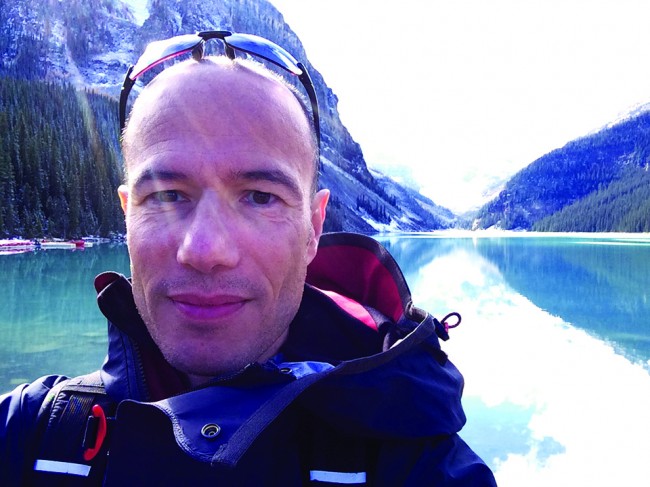Setting Limits on the Unknown
October 21, 2014
New Jackson School researcher Patrick Heimbach works to reduce the uncertainties of climate simulations
By Tim Green

Scientists who develop computer models that simulate climate wrestle with uncertainty. It’s a fact of the profession.
There are so many complex variables that go into a simulation that at times modelers have to rely on the best estimated data or just put “x” in places where no data are available.
Patrick Heimbach, a climate modeler who will join the University of Texas at Austin in January 2015, is working to get a better handle on these unknowns. His goal is to increase the accuracy of the models simulating future conditions to help scientists better understand how climate change might happen and the impact it could have around the world.
Heimbach, who comes to Austin after 15 years at MIT, specializes in research aimed at understanding the global circulation of the ocean and its role in the global climate system and in the dynamics of Arctic sea ice and polar ice sheets.
He joins researchers working on that problem at the Jackson School of Geosciences and its Institute for Geophysics (UTIG) and at the Institute for Computational Engineering and Sciences (ICES). Heimbach will add to an already strong cadre of climate researchers at the university, said Omar Ghattas, a researcher also affiliated with the Jackson School and ICES.
“Patrick Heimbach is one of the world’s leading authorities on data assimilation in ocean models,” Ghattas said. “His research addresses the question of how we can best extract knowledge about ocean systems from ever-expanding data volumes and make ocean models more predictive.”
Heimbach is joining the university as a W. A. “Tex” Moncrief, Jr. Simulation-Based Engineering Science Professor. The position was created to bring advances in computer modeling and simulation to bear on the scientific and engineering challenges that affect our nation’s well-being and competitiveness.
In an interview in August, Heimbach said he was looking forward to working with researchers doing innovative work in the area of uncertainty quantification, which he calls one of the open frontiers in climate modeling research and the effort to create better models.“Colleagues at UT-Austin’s Institute for Computational Engineering and Science are at the cutting edge worldwide to try to develop methodologies on how you can rigorously tackle this problem,” he said.
It’s a challenge that demands a lot of computing power. Heimbach is ready to get his hands on the university’s high performance systems such as those at the Texas Advanced Computing Center (TACC).
“Computing resources are absolutely critical because these models are getting very sophisticated, very complex,” Heimbach said. “Without them, there’s very little you can do at the end of the day.”
He hopes to use some of his start-up funding for his laboratory to contribute to TACC’s resources. Heimbach also looks forward to collaborating with UTIG scientists conducting groundbreaking airborne surveys to collect data around Antarctica’s and Greenland’s marine margins.
“I’m very keen on working with them and advancing ideas in ocean, ice and climate research,” he said.
Heimbach’s computational approaches are generally based on inverse modeling. He tries to learn from building computer models that accurately reflect events that have already occurred. He compared the method to the high school mathematics exercise in which a student tries to plot the best fit of a line through a scattering of data points.
“That fit is your optimal model representation of the data,” he said of the line. “Here what we do is similar, but with much more complex models, models that run on supercomputers and many more data sets.”
An example is a model of the Labrador Sea, just southwest of Greenland, that Heimbach and MIT colleagues developed.
The simulation was based on a method that Heimbach developed with one of his graduate students. The method combined models and observations to accurately simulate the seasonal extent of Arctic sea ice and the ocean circulation beneath, according to an MIT report on the research.
“We’re slowly trying to improve detailed understanding of the underlying processes through model simulations that are confirmed by observations,” he said. Heimbach said the method could be applied to the Arctic Ocean as a whole, which could be useful for companies trying to navigate the ocean. That’s because, while there has been a trend toward less ice in the Arctic Ocean during the summers, there is still no guarantee it will be completely navigable.
Heimbach pointed to September 2012 when sea ice reached a historic minimum. Nevertheless, several oil companies had to cut short exploratory drilling projects when confronted with unexpected ice.
“Naively you wouldn’t expect that because you are in an all-time minimum,” Heimbach said. “But one has to be really careful to understand regional changes that would look different in different years and different regions.”
In addition to cultivating better climate models, Heimbach also works to cultivate a new generation of climate scientists. Together with colleagues in Norway, he is a cofounder, organizer and teacher in an annual series of climate dynamics courses for advanced graduate students and post-docs.
Held in 2014 in August on Disko Island off the west coast of Greenland, the topic was the dynamics of the Greenland Ice Sheet. The classes afford Heimbach, who does most of his research at a computer, the opportunity to get closer to the environments he studies.
“Sometimes it’s very healthy for a modeler to actually get out and see the system you’re trying to simulate and get a bit humbled by the complexity,” he said.
Of that, he’s certain.
Back to the Newsletter